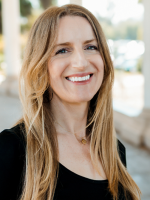Visual artist Nassem Navab recently moved back to San Diego from Tucson after studying at University of Arizona. She’d built up some connections here, worked as an artist assistant, began applying for teaching jobs, residences and exhibitions and was accepted into the 2020 group of artists-in-residence at North Park's Art Produce gallery.
And then, before her 7-week residency even began, the pandemic struck.
Art Produce, with its doors closed to the public, has continued its residency program as creatively as possible. The building is divided into several segments, so two artists can work in a studio and never interact with the other artist.
Navab's residency is in the gallery’s "Cooler Room," in the back and away from any University Avenue passersby. Under ordinary circumstances, the space is a dream: High ceilings, south-facing windows flooded with light throughout the day and access directly into Art Produce's lovely garden space, which encourages visitors to mingle and dwell in any exhibitions. But with galleries closed, the gardens are inaccessible, and Navab's in-studio residence is largely cut off.

Navab, whose parents immigrated from Iran, explores in her art the cultural displacement experienced in immigrant families, particularly how children of immigrants exist with objects and furniture in the home that are either remnants of a former country or a new country pressing its way into the immigrant home. Experiencing this phenomenon as an adjacency to the traumas of their parents' immigration is formative, Navab explains, and passes on a version of trauma too.
Navab noticed a unique relationship between children of immigrants from a range of backgrounds and the objects in their homes. "I'm very interested in the human habit, the human need that is formed from what you could call a collective trauma," she said. "It's how I have not experienced the same things my parents experienced when they were living in Iran, but I’ve heard their stories, I’ve heard them communicate those fears and successes in their lives and how I took that information and became myself."
Navab was raised with clear plastic vinyl covers to protect the furniture in her house, removed only when guests were coming. She realized, as she grew up, that it wasn't just her parents, or just immigrants from Iran who protected furniture with plastic.

It stems from the idea that owning something nice is precious, and that thing has to last. "But at that point, are they actually using the furniture themselves? Are they experiencing that furniture? Or are they just protecting that idea?" she said.
Using the clear plastic vinyl of her childhood, Navab wraps up domestic objects ranging from sentimental pieces or things imported from home — like her mother's hijab headscarf that Navab only remembers her mother wearing during passport photos — or more mundane objects like decorative tissue boxes or small pieces of furniture. The mixture of items from western culture and a family's original country is a hallmark of immigrant homes, she said.
"I think there's a universal connection with this desire to be entering into this western world that we live in in the U.S.," Navab said. "And how all these connected domestic objects connect all of us children of immigrant families."
In her art, Navab takes it to an extreme. She sews the vinyl around objects with gold thread, a way of representing the scars or traumas of displacement. She is currently installing her mother's headscarf at Art Produce as if it were suspended in air, anchored to the ground with gold thread attached to a set of bricks stitched inside clear plastic.

Together with Art Produce, Navab is attempting to adapt to pandemic audiences. She has taken over Art Produce's Instagram account a few times, touring her work and participated in artist conversations. But she's skeptical of Instagram, and though it's one of the few tools right now for sharing, documenting and archiving artistic work, she thinks the sheer volume of information there now impacts the depth of engagement. "We are all so bombarded by Instagram right now," she said. "Do people want to engage in those spaces, and even if they do, will they fully understand those pieces?"
But for the remainder of her residency, she'll still install her work in the gallery, and still prepare to share it with audiences, even if they don't physically show up or can only visit in social-distanced ways. Navab is trying to find ways to encourage interaction with her work as she continues to create. She wants people from different walks of life to come in and experience it, and ultimately share their own stories. She’s not sure virtual platforms are the right space for that. For now, she's having to deal with the altered audience landscape as best she can.
"That’s all I have right now. That’s all a lot of us have. The best we can do is keep pushing through and try to figure out other ways to disrupt this," Navab said.
Disruption, to Navab, means to look at something in a new light, and disrupting the ways of sharing art during a global crisis means she is trying to think outside the box. For her, it’s taking the inner spaces of artists' work and meeting the audiences where they are, which is a public realm.
Ultimately, she's relieved to have a residency, as unusual as the timing is. "It is very difficult right now, someone coming into the field right now, and trying to show themselves to the world. You can't even apply to shows, you can't even apply to exhibitions. Everything is on hold. Everything is unknown," she said.
Learn more about Art Produce's artist in residence program here.






